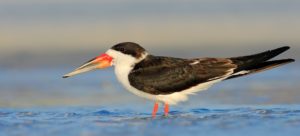First the good news: according to Lorraine Margeson, black skimmer are nesting on Fort DeSoto Beach for the first time in decades. Then two chunks of bad news: stewards are desperately needed to protect the baby birds from beachgoers, and scientists say they will never be able to pinpoint the cause of death for last summer’s lost skimmers.
According to Katheryn Harris, the Florida Fish and Wildlife Conservation Commission’s regional shorebird coordinator, scientists may never be able to pinpoint the cause of the black skimmers die-off on Pinellas County beaches last year. About 50 black skimmer chicks died in August and September 2016. Black skimmers are currently protected by the U.S. Migratory Bird Treaty Act and are listed as threatened on Florida’s Endangered and Threatened Species.
“The cause of death was a strain of salmonella, but we’re not sure where or how it was introduced,” said Harris. Although salmonella is typically seen in bird populations, this deadly strain is not naturally found.
The bird carcasses were examined by labs in Florida and the University of Georgia, which has facilities capable of more detailed testing, she added.
The birds were discovered in early September by Dr. Elizabeth Foyrs, an Eckerd College professor who had been banding chicks before they fledged. Tropical Storm Colin, which dumped about 10 inches of rain in parts of Pinellas County in early June, caused the first sewage overflow of the year. The second storm, Hurricane Hermine, came through Sept. 3 with more than 20 inches of rain. (See Bay Soundings January 2016 to learn more about the link between rainfall and wastewater discharges.)
Sewage overflows in Boca Ciega Bay, where tidal flow is limited were suspected in the skimmer deaths targeted as the cause of the deaths, but Harris said it would be very hard to confirm a link between the mortality event and the overflows. Red Tide, a naturally occurring harmful algal bloom that can be exacerbated by nutrients found in both storm and wastewater, also was present in the area when the deaths were documented. While the investigation is ongoing, the source of the salmonella may not be definitively determined.

